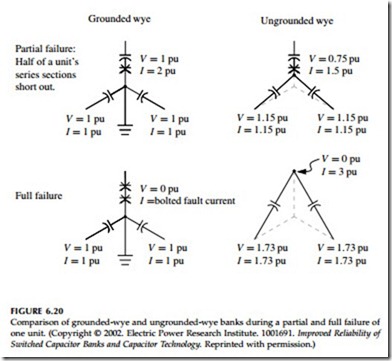Grounding
Three-phase capacitors can be grounded in a wye configuration or ungrounded, either in a floating-wye or a delta. For multigrounded distribution systems, a grounded-wye capacitor bank offers advantages and dis- advantages:
• Unit failure and fault current — If a unit fails, the faulted phase draws full fault current. This allows the fuse to blow quickly, but requires fuses to be rated for the full fault current.
• Harmonics — The grounded-wye bank can attract zero-sequence harmonics (balanced 3rd, 9th, 15th, …). This problem is often found in telephone interference cases.
Advantages and disadvantages of the floating-wye, ungrounded banks include
• Unit failure — The collapse of voltage across a failed unit pulls the floating neutral to phase voltage. Now, the neutral shift stresses the remaining capacitors with line-to-line voltage, 173% of the capaci- tor’s rating.
• Fault current — When one unit fails, the circuit does not draw full fault current — it is a high-impedance fault. This is an advantage in some capacitor applications.
• Harmonics — Less chance of harmonic problems because the ungrounded, zero-sequence harmonics (balanced 3rd, 9th, 15th, …) cannot flow to ground through the capacitor.
The response of the floating-wye configuration deserves more analysis. During a progressive failure, when one series section shorts out, the shift of the neutral relieves the voltage stress on the remaining series sections. In the example in Figure 6.20, for a floating-wye bank with half of the series sections shorted, the line-to-neutral voltage becomes 0.75 per unit. The remaining elements normally see 50% of the line-to-neutral voltage, but now they see 75% (1.5 per unit, so the current is also 1.5 times normal). The reduction in voltage stress due to the neutral shift prolongs the failure — not what we want. The excess heating at the failure point increases the risk of gas gener- ation and case rupture. When one element fails, we really want the fuse (or other protection) to trip quickly. The neutral shift also increases the voltage stress on the units on the other phases.
Floating-wye configurations are best applied with neutral detection — a potential transformer measuring voltage between the floating neutral and ground can detect a failure of one unit. When one unit fails, a relay moni- toring the neutral PT should trip the capacitor’s oil or vacuum switch (obvi- ously, this only works on switched banks).
Standard utility practice is to ground banks on multigrounded systems. Over 80% of the respondents to an EPRI survey used grounded-wye capacitor connections (EPRI 1001691, 2002). On three-wire systems, utilities use both ungrounded-wye and delta configurations.
Most utilities use two-bushing capacitors, even though most also use a grounded neutral. Having two bushings allows crews to convert capacitor banks to a floating neutral configuration if telephone interference is a problem. Utilities universally ground capacitor cases on pole-mounted capacitors (even though it is not strictly required by the National Electrical Safety Code [IEEE C2-1997]). In rare cases, banks with single-bushing capacitors are floated when it becomes necessary to convert a bank to a floating-wye. Avoid this if possible.
